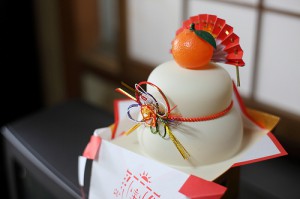Informant’s self-description: “I am a large melting pot of everyone that I have ever met. Even if I did not really know who they were. And that makes me me! And different from everyone, ‘cause we all have different experiences. I am a video game person that loves a video game, and I love things that aren’t actually real life. But I also like real life! But sometimes fiction more so because the boundaries of what can be done are expanded. And that’s really cool to me. I like food – a lot. And I am a person that just wants to do a lot of things all the time. Forever.”
—
Are there any traditional food dishes that you consume or make on particular occasions?
Um, yes. Every New Year’s – well, Christmas and New Year’s, but because they’re so close together they just kinda happen in that sort of time slot. Christmas, my mom always makes this certain rice cake soup, it has – or mochi soup – and she prepares it all day, and then she makes the soup, and we have to eat it for dinner. And she adds eggs, and green onions, and seaweed, and we all sit down and we get special silverware and bowls out, and eat that for dinner, and then on New Year’s day, you have to eat the same thing, or you have to eat the mochi soup. It doesn’t have to be the exact same one from before because that would be nasty. But it would be like a new batch – the same recipe, obviously. And then you have to eat it for good luck in the New Year. And if you don’t you’ll have bad luck. But I haven’t experienced that yet because I’ve never turned down a bowl of my mother’s soup. Because why would you. Yeah- that’s the only sort of traditional thing that we have in my family.
You’ve always had mochi soup –
Since I can remember, yeah.
Do you like it?
I like it a lot. I kind of want it now.
Have you ever helped make it?
Uh, yes. Actually, I forgot a part of it- Once we were old enough, my mom made me and my two younger sisters – we made little dumplings, or I guess gyoza in Japanese. Little dumplings with pork and spices and meats and vegetables. We make the dumplings, and that’s a thing we always have to do on Chistmas and New Year’s Eve. Then my mom puts them in the soup and you can see all the little dumplings that you’ve made and usually we make really weird shapes. So sometimes you’ll get a nice little round moon shape and then you’ll get, like, a rectangle, and then they fall apart and you just have to have dumplings in your soup everywhere.
Do you try to make them into particular shapes?
Sometimes yeah, sometimes yeah. I tried to make a snowman dumpling once, and he kinda looked like a malformed sugar snap pea after. I was sad.
Was there a reason for the snowman?
I mean, it was Christmasy, sort of, and I was like “Oh, if we can shape dumplings, that’s sort of like shaping cookies when we make them for Santa. So I can just like form this with my fingers,” and then it fell apart, because she had to deep fry it and he was just kind of sad. And ripped apart. But it was ok, because it tasted delicious.
You helped make the dumplings – your mom makes the rest of it?
Mostly. It’s a pretty basic process, just making the broth, and then she throws in the little dumplings and the rice cakes. But she’s a very excellent cook so I wouldn’t want to disrupt anything in her kitchen – she’s a gale force wind when we step in and she’s not expecting us. It’s a danger zone.
Is it just your family? OR a tradition that many other people take part of?
I think it’s a Korean – well, Korean / Japanese tradition. My mother’s side of the family is Korean and it’s what she does, it’s what her side of the family does, but my baa-chan, or my grandma on my dad’s side who is Japanese – she always comes over and it seems like it’s something that she does too. She lives alone, and right next door to us, so she always comes over for all family celebrations. So I assume that it’s maybe just like a Far Eastern – Asian sort of deal. Maybe. I mean, it seems that way. I met a couple other families who do the same thing, Japanese or Korean.
Is there any symbolism to the food? Like the rice cake part of it?
I don’t really know. I feel like rice cakes in general are just kind of important to – maybe not the Korean culture so much as the Japanese culture because my grandma, my baa-chan, she sometimes throughout the year – she’ll just be making large things of rice cakes. Just in the kitchen. And there’s no reason for it, she’s just doing it. And I’m like “Ok…!” And there’s just like a lot of rice, and a little machine going around that like smashes it and whirls it around and stuff. But I think specifically would be for Japanese holidays and New Year’s and Christmas. But I mean she kind of just does them whenever.
Do you speak fluent Japanese?
I don’t, I unfortunately speak neither of my family languages. I know how to say very basic things.
—
Informant gives lots of background to the mochi soup. Informant sounds fond in description, and it makes them think of the family they love.

